When thinking of Canada, you probably imagine snowy mountains, countless lakes, spectacular wildlife and of course, a good drizzling of maple syrup and the occasional uttering of, eh?
Canada is the second-largest country in the world, and much of Canada is a natural wonderland. You can be in any province or territory and feel utterly connected to nature. From Newfoundland and Labrador on the east coast to British Columbia in the west, all of Canada’s 13 provinces and territories have something unique and interesting to offer in terms of nature and wildlife. With 48 national parks stretched out across the country, a trip to Canada will only leave you wanting to return to discover all the other parts you couldn’t squeeze into your initial trip.
Canada is one of my favourite countries. I was lucky enough to study for a year in London, Ontario, and took a couple of epic road trips from Calgary, heading west through the Rocky Mountains. I’ve been fortunate enough to spot black bears along the Bow Valley Parkway, watch the majestic moose, sneak a peek of the rare wolverine, hear the peaceful call of the common loon and, of course, have some everyday encounters with the overconfident Canada goose.
Spectacular mountain and lake scenery coupled with an abundance of fascinating wildlife makes Canada a great destination. From whale watching on the east coast, try your luck spotting the Canadian Lynx or search for moose. If you love wildlife, Canada is the destination for you.
Contents
20 Animals In Canada (From A to Z)
Arctic Wolf
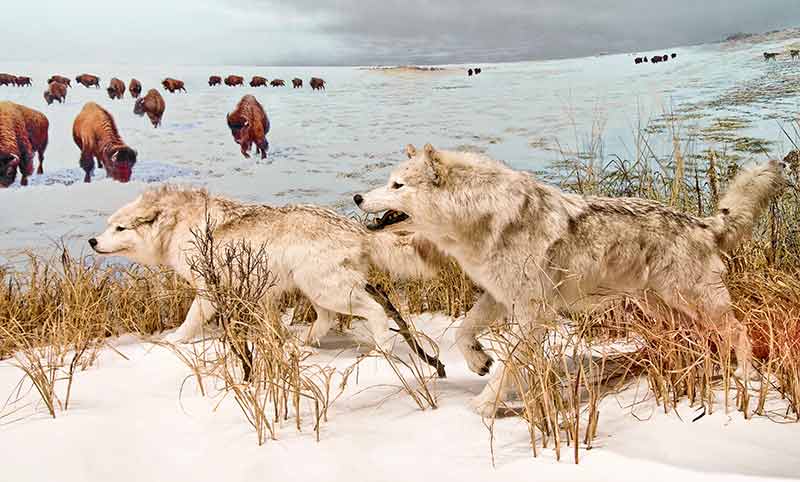
Scientific name: Canis lupus arctos.
Location: Nunavut, Yukon, Northwest Territories.
There are believed to be around 200,000 Arctic wolves worldwide. These wolves live in some of the coldest parts of Canada, where few humans live, hence why they appear to be thriving.
The inner part of the wolf fur is waterproof, making it highly adaptable to cold, snowy climates. Naujaat in Nunavut is near Ukkusiksalik National Park is a habitat for Arctic animals, including wolves, but you will have to fly as there are no roads.
Atlantic Puffin
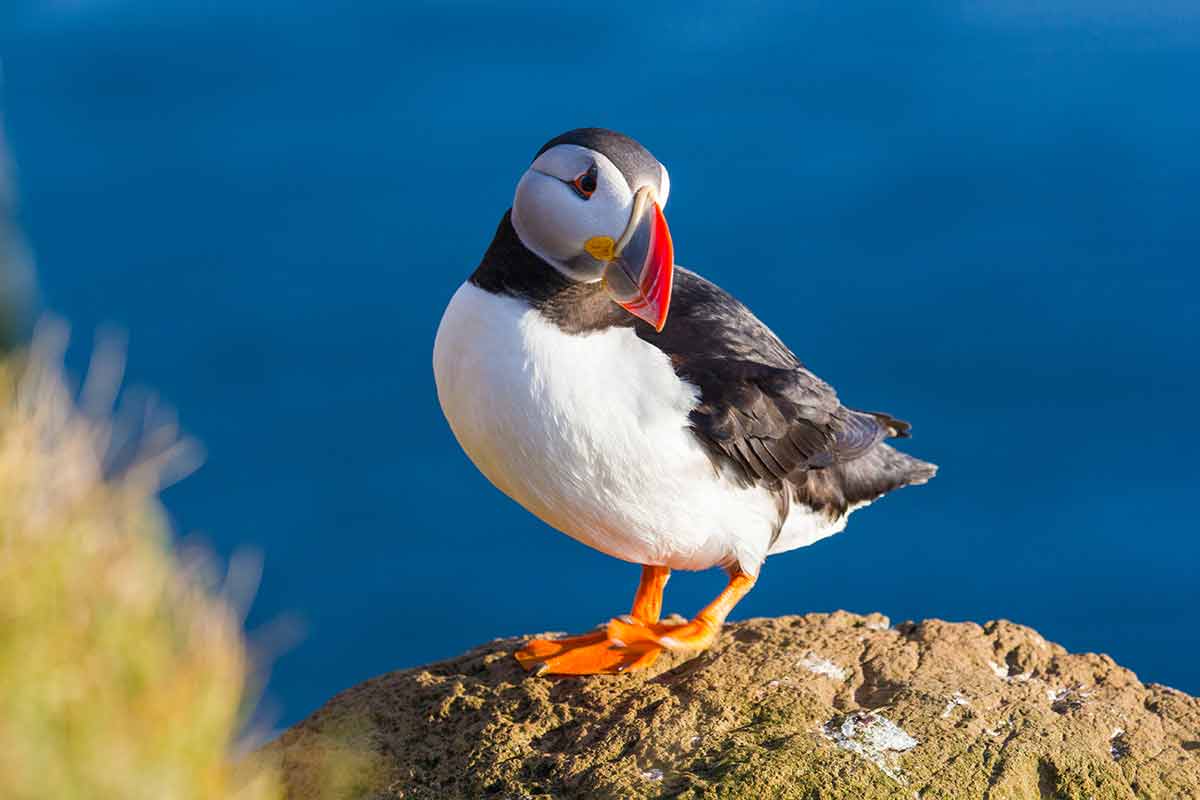
Scientific name: Fratercula.
Location: Avalon Peninsula, Newfoundland and Labrador. There are also some colonies in Nova Scotia.
The colourful beaked Atlantic puffin is a Newfoundland native. Nicknamed the sea parrot, puffins can be found in large numbers along the cliffs of the Witless Bay Ecological Reserve in the south of the province.
I have forever held a certain fondness for puffins when I discovered that babies are called pufflings, such an adorable name.
Spring in Canada brings with it the Atlantic puffin breeding season when around 350,000 puffins breed in Newfoundland and Labrador.
Bald Eagle
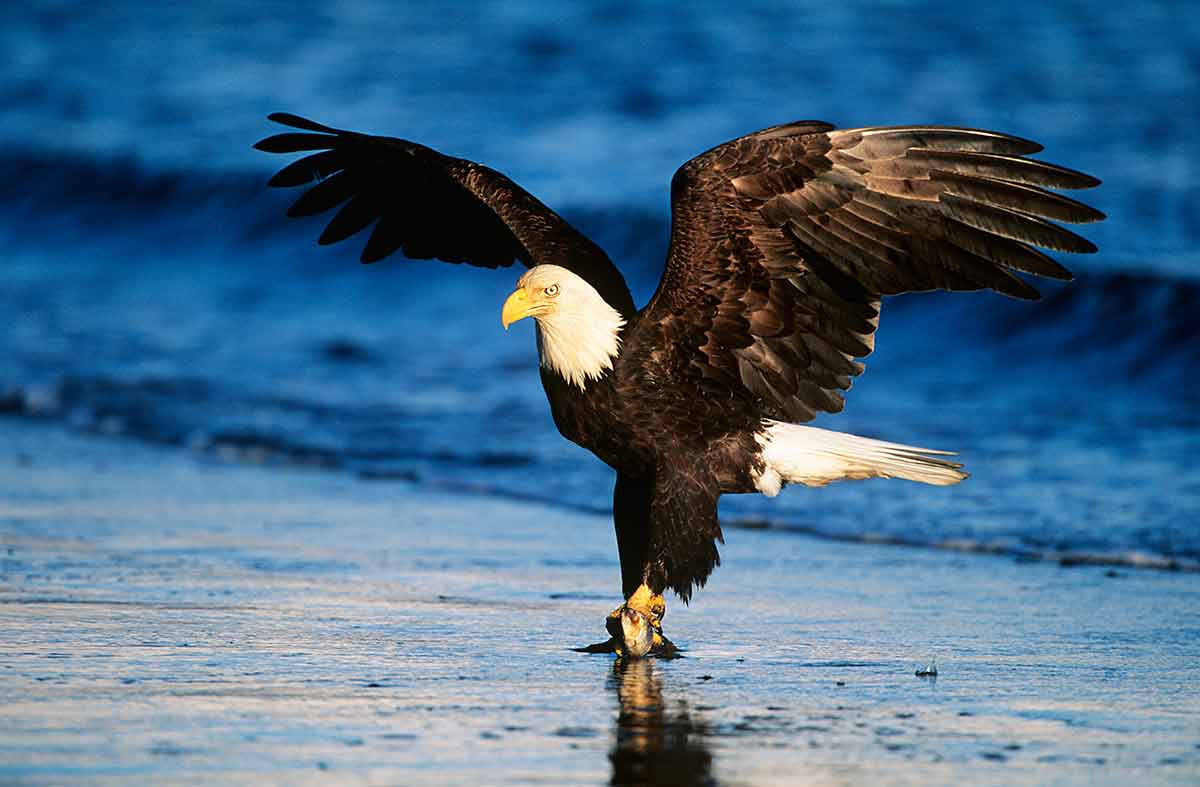
Scientific name: Haliaeetus leucocephalus.
Location: Predominately British Columbia but also Alberta, Saskatchewan, Manitoba and northwestern Ontario.
Watching a bald eagle circling is a captivating sight. They appear to swoop and turn most smoothly and efficiently majestically.
In fact, these birds’ bodies even adapt to make them hyper-efficient. When a bald eagle loses a feather on one wing, it will shed a feather on the other wing to continue to be balanced.
British Columbia outdoes itself with around 20,000 bald eagles living in the province.
Beaver
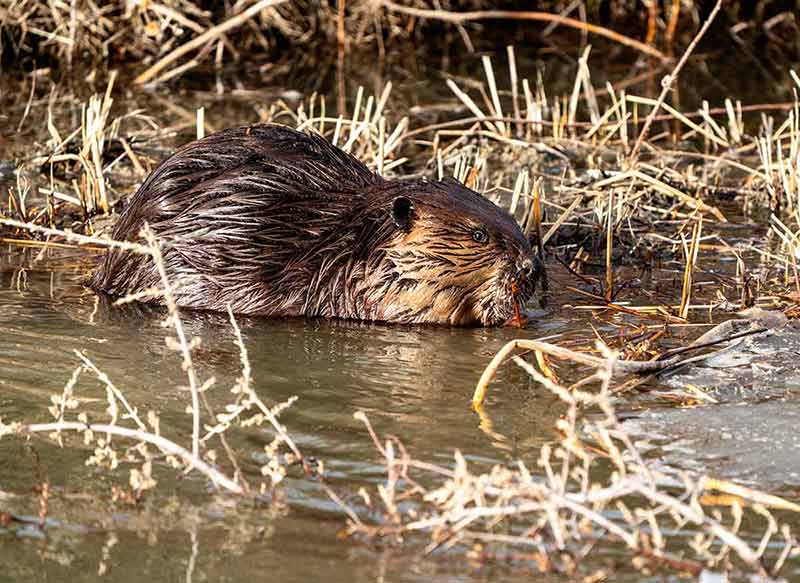
Scientific name: Castor.
Location: In lakes, creeks and streams all over Canada.
Beavers have long been a part of Canadian culture and the natural landscape and are the country’s national animal. However, during the 1600s, the beaver nearly became extinct as it was popular for making hats for men in Canada and Europe.
Luckily, as fashion trends moved towards silk, the beaver began to flourish again in Canada and now it can be seen on rather a lot of everyday items. Canada’s first official postage stamp in 1975 has the beaver sitting proud and so does the five-cent coin.
The beaver uses its paddle-shaped tail for a variety of purposes. Beavers can be seen slapping the water with them to warn off predators as well as using them as an energy storage unit. But have you ever tried beaver tails? Wait for it… don’t worry, animal lovers and conservationists, I’m talking about Canada’s famous fried dough pasty. Named after the animal due to its shape, these yummy desserts come covered in a variety of flavours, chocolate, peanut butter, banana, and cinnamon. They are a must-try Canadian dessert snack.
Beavers can be found hard at work all over Canada, particularly around lakes and streams, but they are often quite challenging to spot. Bow Valley Provincial Park in Alberta is an excellent place to try your luck and where you can also soak up the incredible rugged mountain views.
Bison
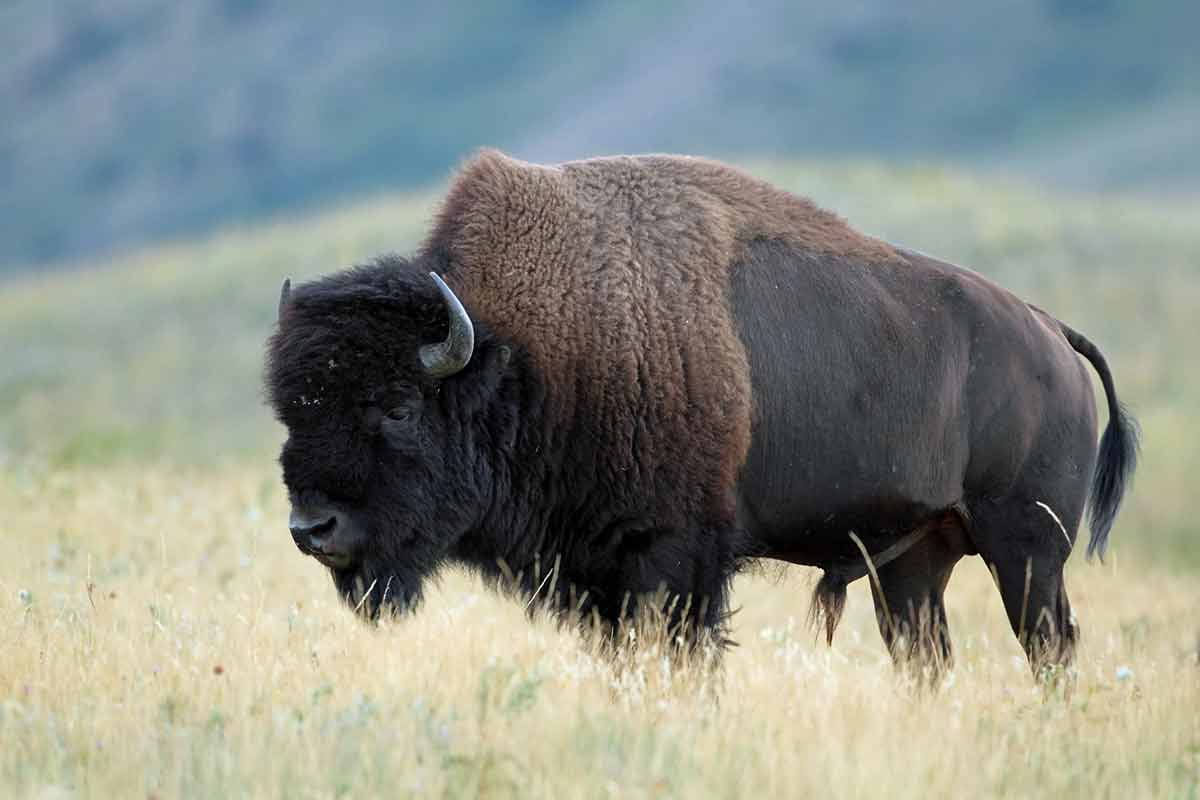
Scientific name: Bison.
Location: Alberta, British Columbia, Manitoba, Northwest Territories, Saskatchewan and Yukon. Wood Buffalo National Park and Elk Island National Park in Alberta.
Wood Buffalo National Park, which straddles Alberta and the Northwest Territories, has around 3000 wood bison and is home to the world’s largest free-roaming, self-regulating wood bison herd. Elk Island National Park (shouldn’t it be called Bison Island?) is another contributor to the conservation of bison in Canada.
The scruffy haired, bulky bison is a rather charming animal.
Bison are almost like natural snowploughs, their bulbous hump is full of muscle that supports their backs, making it easier for them to use their heads to plough through the snow.
Beluga Whale

Scientific name: Delphinapterus leucas.
Location: Churchill, Manitoba and Tadoussac, Quebec.
This white friendly whale is effortlessly elegant and can be viewed primarily on the east coast of Canada and the Hudson Bay.
The beluga is born a dark grey colour, and it can take up to eight years before they begin to turn white. By far, the coolest thing about the beluga is that they can change the shape of their bulbous foreheads.
This squishy part of the head is called a melon, and the beluga can change the direction of the sounds they make by wiggling their melons.
Black Bear
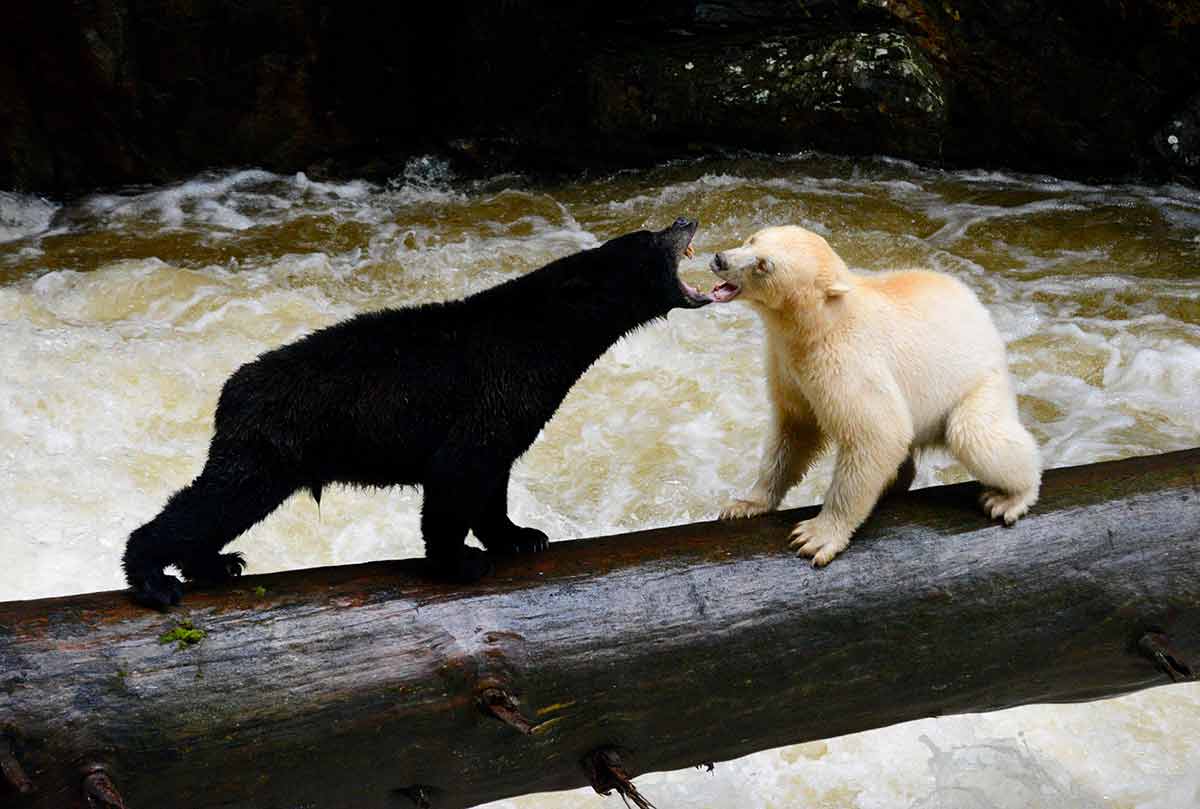
Scientific name: Ursus americanus.
Location: Across Canada in all provinces and territories except Prince Edward Island. British Columbia is the best province to see them.
The smallest of the three types of bears in North America, the black bear, will forever be my favourite animal sighting in Canada.
Driving along the Bow Valley Parkway in Alberta, I was lucky enough to see three black bears, a mother and two adorable cubs, frolicking on a grassy incline next to the road. It shocked me and perhaps disturbed me a little that this bear family were so comfortable playing so close to human civilisation.
If you want to see these beautiful black bears, avoid October to April, as this is their hibernation season. Did you know that black bears do not eat, drink, defecate or urinate during hibernation?
A special kind of black bear is the Kermode bear or spirit bear, a subspecies of the black bear that can mostly be found on Princess Royal Island and Gribbell Island in British Columbia. Kermode bears are not albinos; they have a recessive gene that makes their fur a creamy white colour.
Black Squirrel
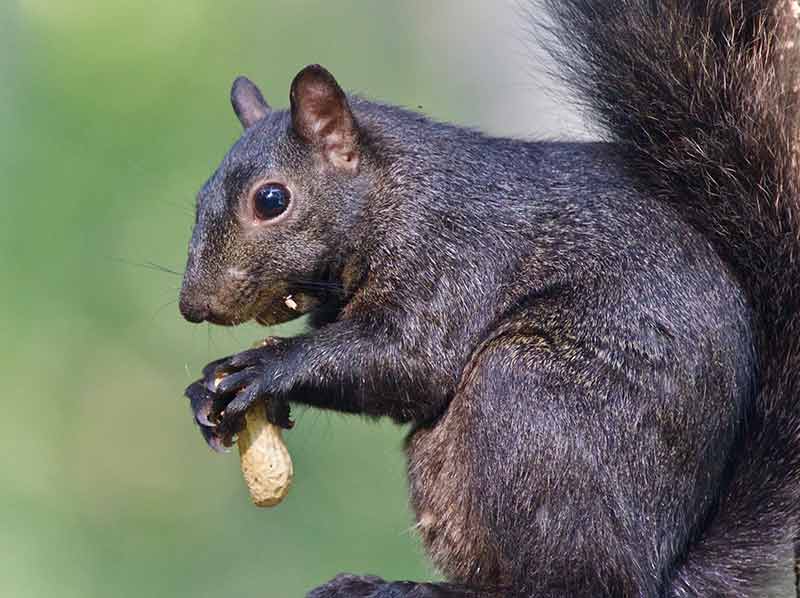
Scientific name: Sciurus carolinensis.
Location: Ontario, Canada.
You may be familiar with the red and grey squirrels, but black squirrels are less common in Canada. Imagine my surprise when I was wandering through a park in London, Ontario, only to see what I thought was a squirrel, but black.
A quick Google search of ‘why are squirrels in Canada black?’ and I had my answer. The black squirrel is a subgroup of the grey squirrel but with more melanism and all the generic squirrel-like tendencies, only a different colour.
Black squirrels are mostly found in Ontario.
Common Loon
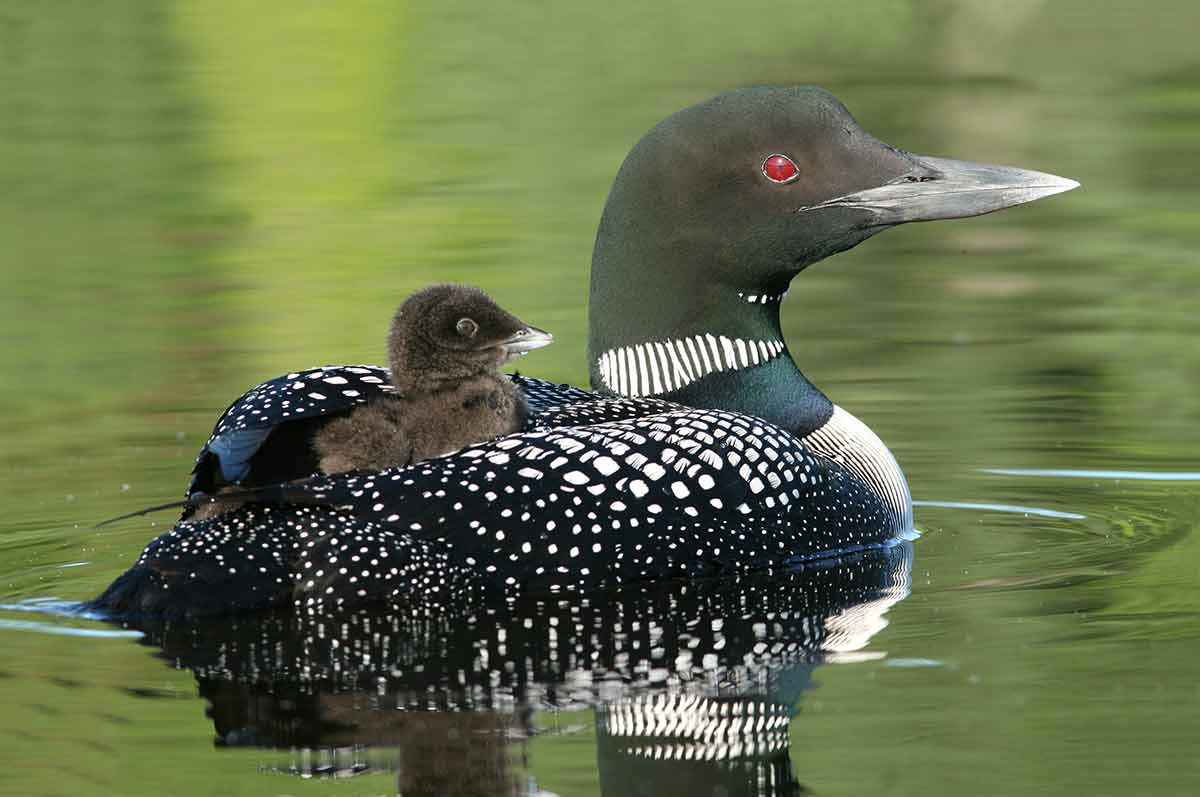
Scientific name: Gavia.
Location: Across Canada.
Also known as the great north diver, this intricately dotted and stripped loon can be seen in most places around the country, except in the far north, where temperatures are too cold.
The sound of a loon calling to its partner in the evening is eerily relaxing and magical. If you ever see a loon on land and walking, you may be concerned believing it to be injured.
That’s because a loon’s legs are set so far back on their bodies that they have to drag their bodies across the land clumsily.
Canada Goose
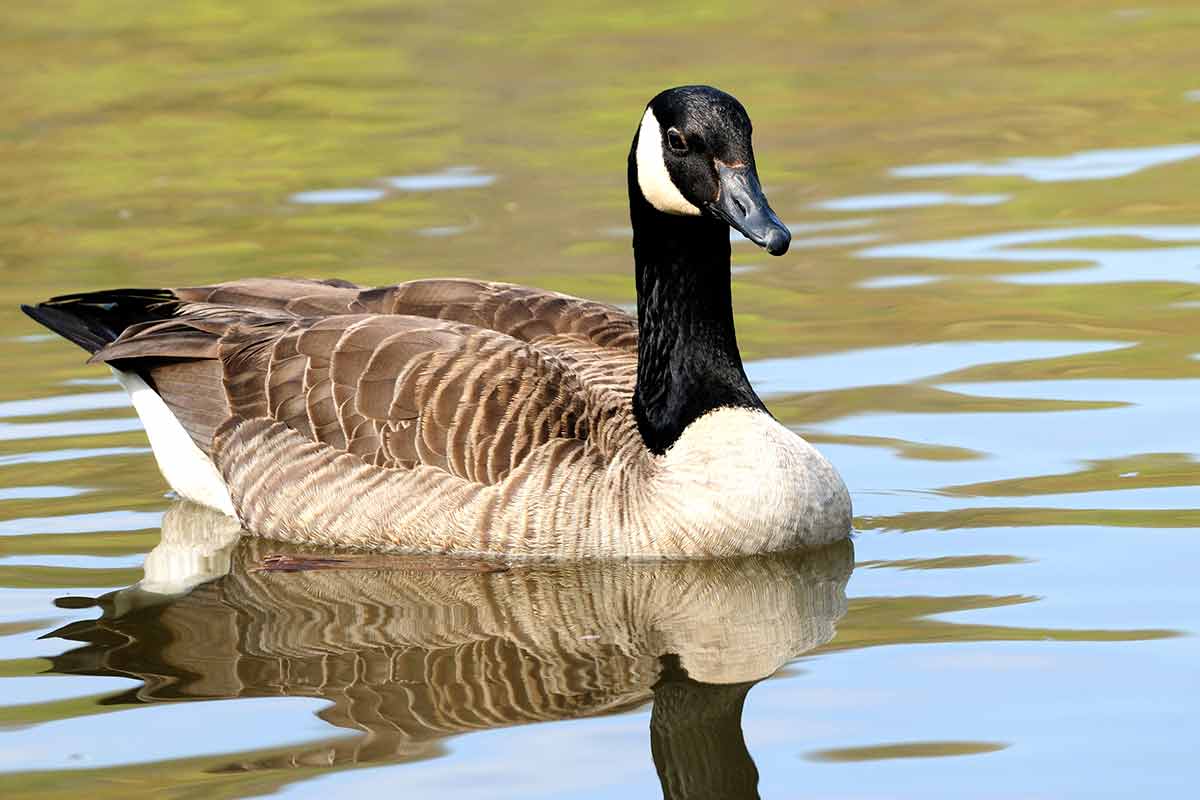
Scientific name: Branta canadensis.
Location: Everywhere.
A list of Canadian animals isn’t complete without mentioning the Canada goose.
These pesky geese are known to travel between 3200 to 4800 km (2,000 to 3,000 miles) during winter, but they sure feel like they make a permanent place for themselves in every single public place in Canada.
Canadian Lynx
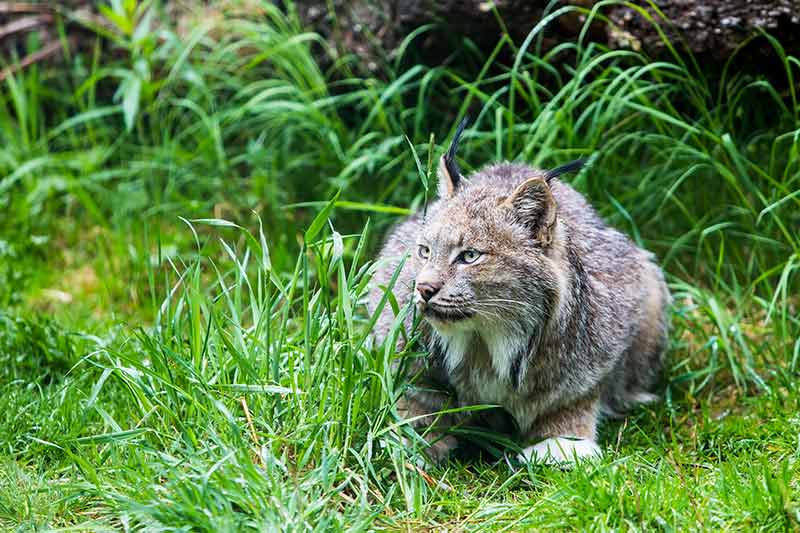
Scientific name: Lynx canadensis.
Location: Yukon.
The Canadian Lynx can mostly be found in Canada’s most northwesterly territory, Yukon, and is one of the countries three wild cats. This intriguing cat has long black tufts on top of its ears to keep debris from entering the ear as well as filtering sound directly into the cat’s ears.
The Canadian Lynx is rare, so you’d have to head to the forests of Yukon to even be in with an infinitesimal chance of seeing one.
Caribou
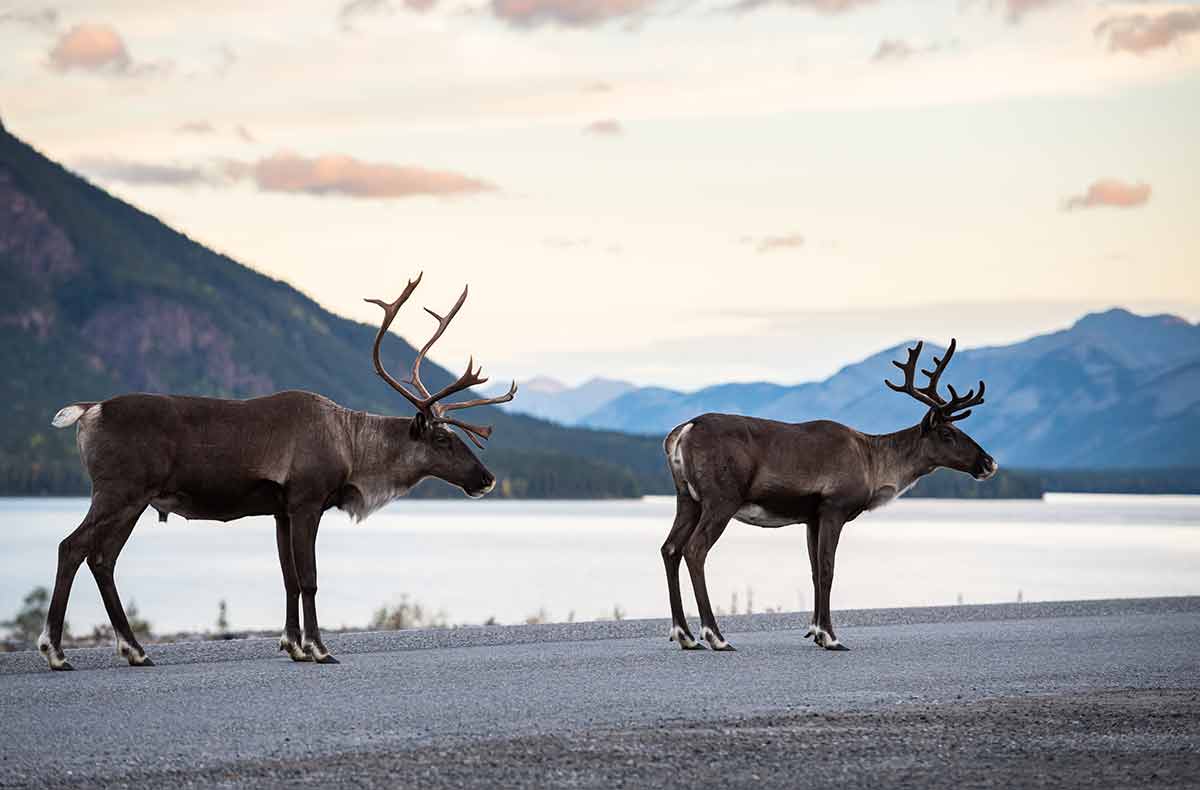
Scientific name: Rangifer tarandus.
Location: Nunavut, Quebec, Northwest Territories.
If you thought mass animal migrations were just for the Serengeti, then think again. Each year in spring, around 350,000 caribou travel from the forests of Quebec to the tundra in Nunavut to give birth away from predators.
Much of their journey consists of treading through thick snow in minus temperatures. Therefore, caribou’s noses have evolved to warm up the air before reaching their lungs.
Caribou are the only types of deer where both male and female caribou have antlers. Barren ground caribou are numerous and can be found in Nunavut and the Northwest Territories, Woodland caribou are the largest while Peary caribou are smaller and lighter coloured.
Cougar (Mountain Lion)
Scientific name: Puma concolor
Location: Western Canada, with the highest concentration in British Columbia.
Another of Canada’s endangered animals is the cougar. So, count yourself lucky if you are ever able to spot one, as there are only around 4,000 in British Columbia.
This powerful cat can kill a 270 kg moose, this knowledge has arguably left many people in fear of the big cat and killing cougars for trophies is surprisingly legal in the province.
Elk
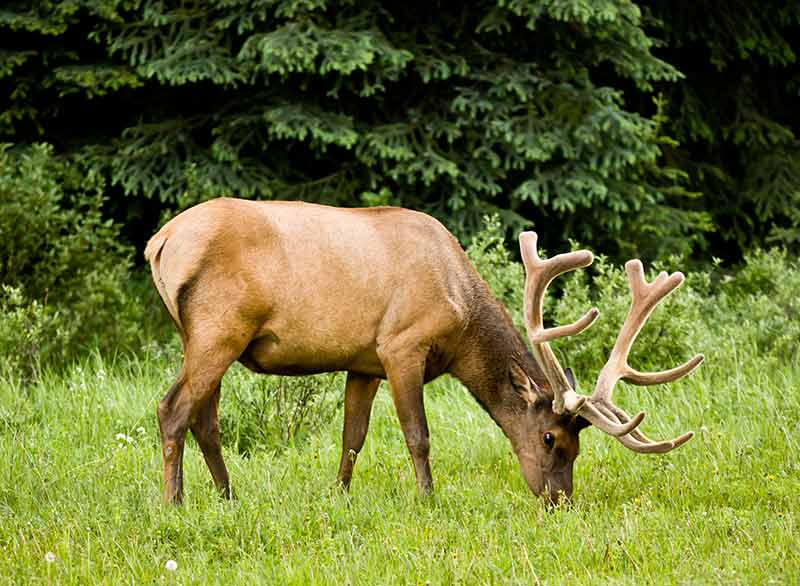
Scientific name: Cervus canadensis
Location: Everywhere, especially Banff National Park and Jasper National Park in Alberta. Over half of Canada’s elk population is in British Columbia.
There are around 72,000 elk in Canada. With so many elk roaming around, it shouldn’t take you too long before you spot one.
Elk are the biggest member of the deer family and have not one but four stomach chambers to aid digestion.
Take the Icefields Parkway heading towards Jasper, and you’ll begin to see “ELK CROSSING” signs, and then you know to keep your eyes peeled.
Grey Whales and Orcas

Scientific name: Eschrichtius robustus (grey whale), Orcinus orca (orca).
Location: Avalon Peninsula, Newfoundland and Labrador.
Canada’s eastern province of Newfoundland and Labrador is world-renowned for whale watching. Known for their colourful houses perched on cliff edges and icebergs floating in the North Atlantic Ocean, no trip to the province is complete without a boat tour to try and spot these large marine mammals.
Orca’s hunt in pods of around 40 family members, making for more successful kills and, lucky for you, often large group sightings.
The grey whale is about 15m long and weighs around 35,000 kg, an incomprehensible size. The grey whale is known to migrate distances of approximately 14,000 miles (22,500km), however, some grey whales didn’t get the memo and choose to stay to eat off the shores of Canada off the coast of British Columbia. I guess that’s lucky for whale watchers!
Grizzly Bear
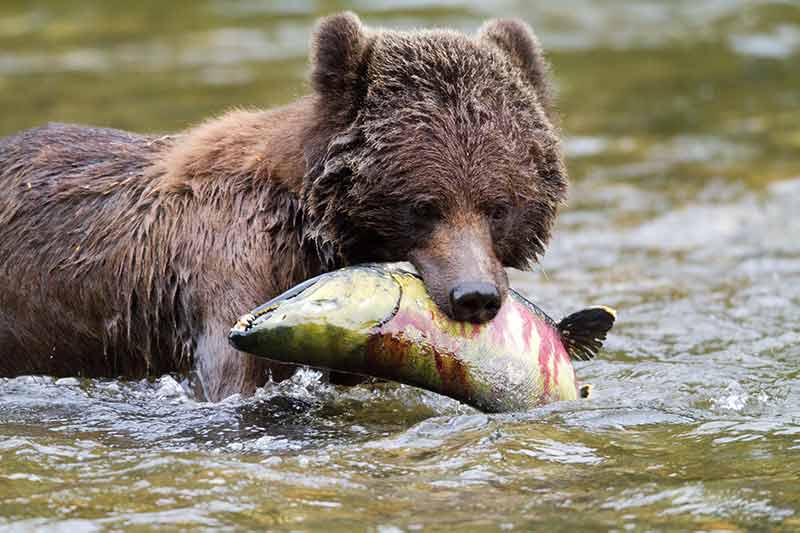
Scientific name: Ursus arctos horribilis.
Location: Bow Valley Parkway and Icefields Parkway Banff National Park, Alberta.
Great Bear Rainforest in British Columbia.
The beaver might be Canada’s national animal, but the big ole grizzly bear is undoubtedly on most people’s nature bucket lists. Of the 25,000 grizzly bears in Canada, 15,000 of those can be found in British Columbia.
My incredible grizzly sighting was along the Bow Valley Parkway in Banff National Park, but the chances of seeing one of these lolloping creatures is rare unless you go on a tour. So my advice for viewing grizzlies would be not to expect to see any, then you will be entirely in awe if you are lucky enough to spot one.
You may also choose to head to the Great Bear Rainforest in British Columbia to try your luck there. A park rancher told us that although many visitors picture bears as aggressive carnivores, a grizzly’s diet is comprised of less than 20% meat. My grizzly experience included a fleeting glimpse of a wandering bear through the trees, maybe just 10 seconds at most, but one that gave me goosebumps all the same.
Moose
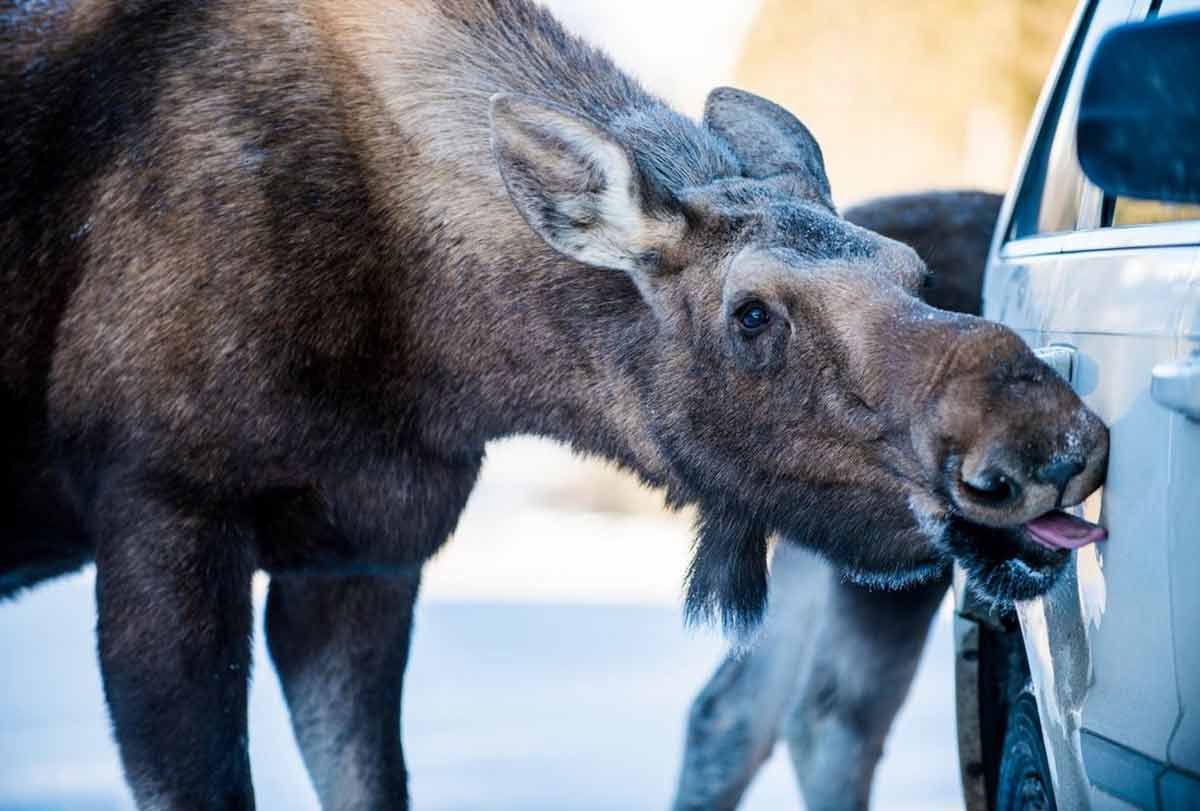
Scientific name: Alces Alces.
Location: Banff and Jasper National Parks in Alberta, Algonquin Provincial Park, Ontario.
While in Canada, searching for moose became somewhat of an addiction. Camera constantly at the ready, I would end up dizzy from staring out of the car window through the flickering trees just waiting to scream “A MOOSE!” Searching for these gangly legged, massive, bodied beings was almost as fun as seeing one in person.
As we approached open meadows, we would warn the rest of the car’s occupants of potential moose sightings exclaiming, “There’s a moose loose aboot this hoose”. For no real reason apart from the phrase was about moose and sounded effortlessly Canadian.
I remember my first moose encounter vividly, somewhere in Banff National Park. He was as still as a statue in the most picturesque pale yellow meadow. He looked so gentle, yet those antlers were so imposingly large.
What struck me about the moose was the dangling fur-covered bell hanging from his throat. Even from a distance, it was clear and just looked so out of place. Zoologists still don’t know exactly what it does, but they believe it may help in spreading the male’s scent. A word of warning, don’t let a moose lick your car.
Polar Bear
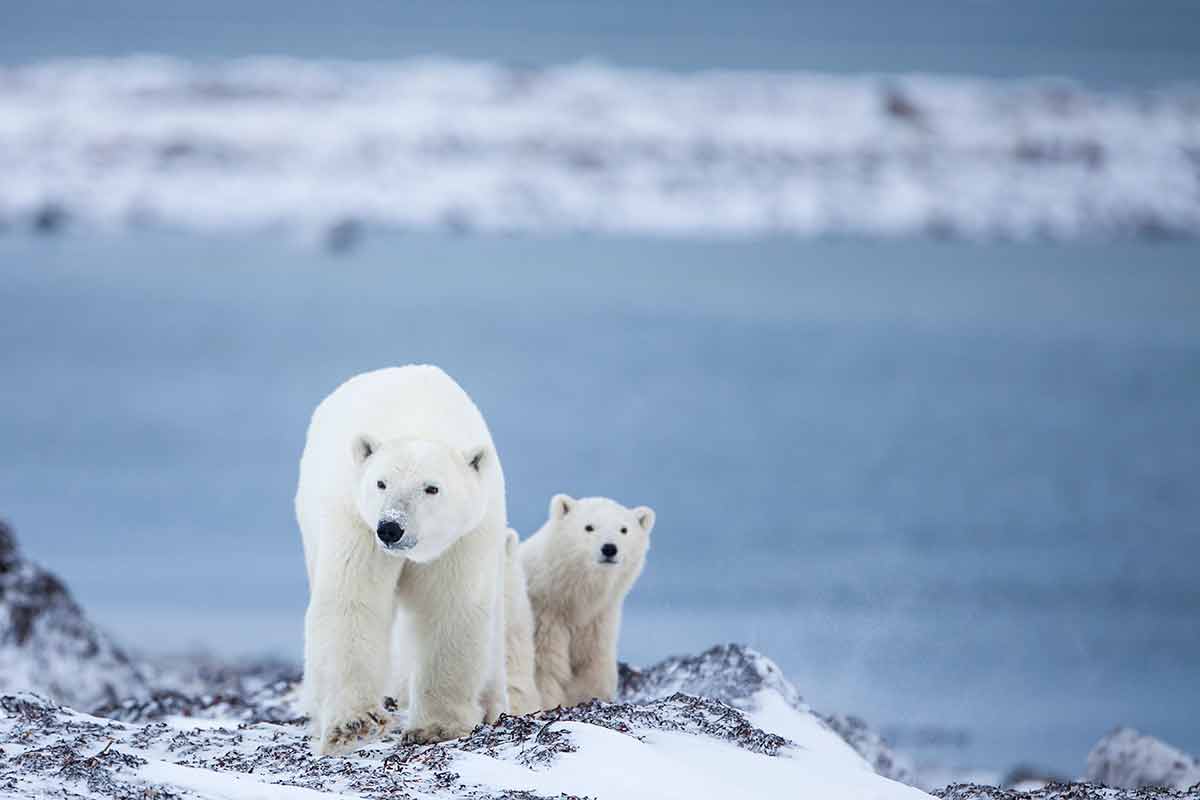
Scientific name: Ursus maritimus.
Location: Churchill (Hudson Bay), Manitoba.
Around 17,000 of the world’s 25,000 polar bears reside in Canada. Churchill, Manitoba, has some of the best and most accessible polar bear viewing in the world, though the season is short.
Only between July and August and October to November will you see them. In summer, these Manitoban polar bears linger in the adjacent tundra, and as winter draws in, the polar bears all gather, waiting for the water to freeze before heading out on the ice in search of seals.
Meanwhile in Canada, discover other wildlife in Manitoba.
Vancouver Island Marmot
Scientific name: Marmota vancouverensis.
Location: Vancouver Island.
This marmot is, you guessed it, found on Vancouver Island, in British Columbia.
It’s endemic to the island, and in 2003, there were believed only to be around 30 marmots, however, through conservation efforts, numbers have increased to about 200 at present, though they are still considered endangered in the province.
Wolverine
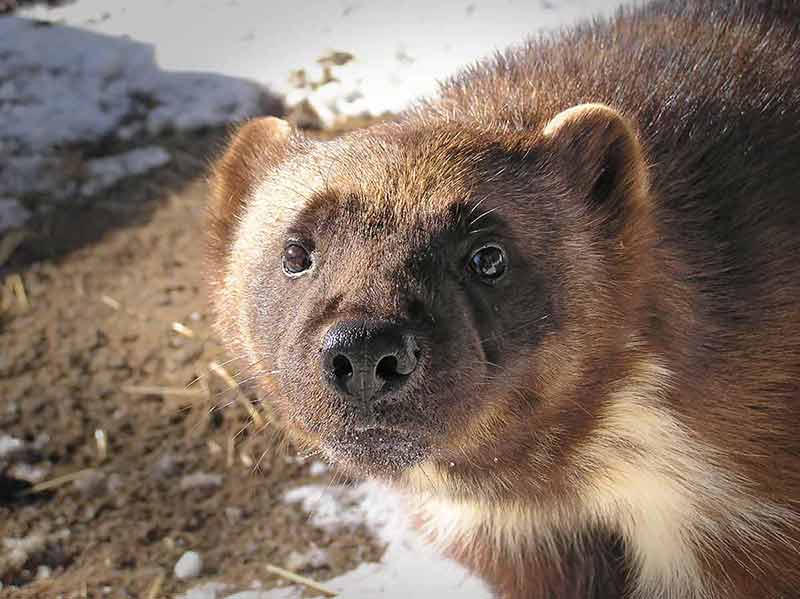
Scientific name: Gulo gulo.
Location: Glacier National Park, British Columbia.
Wolverines are part of the weasel family, short in stature, with long furry bodies, and they have quite the snarling facial expression.
Glacier National Park is an excellent spot to find wolverines, but I give you a warning now, they are extremely rare, most people living in and exploring these parts of Canada will never see one in their entire lifetime.
Perhaps this is because wolverines cover a vast territory, with many known to roam around 1500 sqkm. This being said, on one of my trips to Alberta on our way to the famous Moraine Lake, we saw one scurry across the road.
It was a rare and amazing sighting, and one I will treasure forever.
This post was published in partnership with Destination Canada. Travellers who are fully vaccinated against COVID-19 can enter Canada. For more information go here.
For more about Canada read:
Plan Your Trip

Rent A Car – Find the best car rental rates at Discover Cars. They compare car hire companies to provide you with the best deal right now.

Find A Hotel – If you’re curious about this article and are looking for somewhere to stay, take a look at these amazing hotels.





